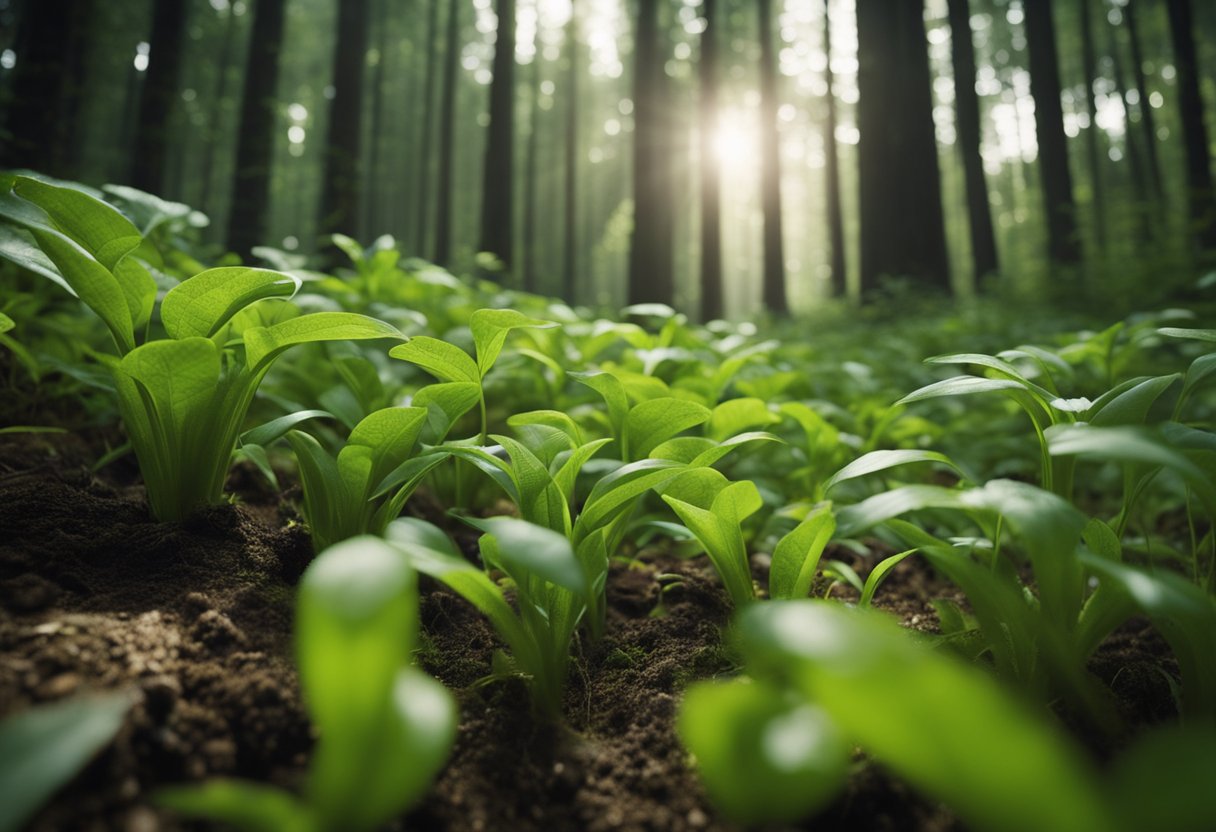The Secret Lives of Plants: Plant Communication and Interaction

Updated On: March 28, 2024 by Eman Sameh
Plants, often perceived as static and silent elements of nature, possess a fascinating realm of interaction and communication beneath their serene exterior. Our botanical companions are not the passive organisms we once believed; they can perceive their surroundings, exchange vital information, and engage in complex behaviours. This rich tapestry of plant life, teeming with unspoken intelligence, is a testament to evolution’s ingenuity. Through advanced scientific research, we are beginning to unravel the mysteries of how vegetation operates, revealing a world where plants memorise, problem-solve, and even socialise.

Investigations into plant behaviour have uncovered that vegetation relies on an intricate communication network, utilising chemical signals, electrical impulses, and other mechanisms to interact with their environment and fellow species. This communication enables them to respond adaptively to various stimuli, such as the presence of pests, changes in weather patterns, and direct harm. Plant communication and their ecosystems are crucial in maintaining the balance of Earth’s climate and fostering biodiversity. Our understanding of this hidden world not only enriches our perspective on plant life but also highlights the profound impact human activities have on these delicate systems.
Plant Communication Mechanisms
In the complex world of flora, plants use several communication mechanisms to interact with their environment and with each other. These interactions are sophisticated, involving chemical signals, root networks, and sensory responses, which together showcase a remarkable form of intelligence.
Chemical Signalling
Plants secrete various chemical compounds that serve as messages, influencing the behaviour of neighbouring plants and other organisms. One well-documented example is the release of volatile organic compounds (VOCs) when a plant is under attack by herbivores. These VOCs can signal to other plants to fortify their own defences and may even attract predators of the herbivores, essentially acting as a cry for help. For instance, studies have shown that certain plants can emit signals received by nearby plants, prompting them to produce substances that deter herbivores or promote resistance to pathogens.
Root Network Collaboration
Beneath the soil, an intricate communication web unfolds through root systems and their fungal partners, namely mycorrhizae. This symbiotic relationship forms the Wood Wide Web, where fungi connect the roots of different plants, allowing them to share resources and information. The exchange includes nutrients, such as nitrogen and phosphorus, warning signals, and sometimes even harmful compounds to thwart the growth of neighbouring competitors.
Sensory Responses
Plants have developed sensory systems to perceive changes in their environment and respond accordingly. Apart from the well-known response to light — phototropism — plants can also react to gravity, pressure, and sound waves. Sensing touch, they can change growth patterns, as seen in the winding vines of climbing plants. The response to sound is an emerging area of research; vibrations may signal environmental changes, like the presence of an insect pest, which then prompts a reaction from the plant.
By harnessing such sophisticated communication mechanisms, be it through the air with chemicals or beneath the ground through root networks; plants display intelligence and a form of sensory perception that is still being explored by our botanists and researchers. Their silent dialogue is a testament to the complexity and interconnectedness of life on our planet.
Plant Perception and Adaptive Behaviours
We’re now delving into the fascinating realm of plant perception and adaptive behaviours, uncovering how plants sense and respond to their environment. These mechanisms highlight the remarkable yet often underestimated intelligence plants exhibit.
Response to Environmental Stimuli
Plants possess a complex array of senses that allow them to perceive subtle changes in their environment. They navigate life by converting environmental stimuli into internal signals, eliciting appropriate responses. For example, through photoreceptors, plants can detect light intensity and direction, enabling them to grow towards the light, a behaviour known as phototropism. This sensory ability ensures that they can maximise photosynthesis to survive.
Temperature also influences plant behaviour. When the temperature fluctuates, plants adjust their metabolism accordingly. Some plants will enter a dormant state during a cold snap to conserve resources, while others produce antifreeze proteins to protect their cells.
- Light: Changes result in growth adjustments for optimal sunlight exposure.
- Temperature: Fluctuations lead to metabolic or developmental changes.
Defence Mechanisms
Plants cannot flee from danger, so they must have sophisticated defence mechanisms to protect themselves from disease and predators. When touched or wounded, plants can release chemical signals that initiate an internal defensive response and warn neighbouring plants of impending threats. This communication sometimes produces toxic substances or reinforcements to their physical structures, such as thorns.
- Chemical signals: Trigger defence responses upon injury that can extend to neighbouring plants.
- Physical barriers: Thorns or tougher tissues developed as a deterrent or protection.
Our understanding of plants’ responsive and protective behaviours provides a window into their unique, albeit different, form of intelligence. Investigations into their capacity for memory, similar to a simple form of consciousness, continue to change our perspectives, emphasising plants’ key role in Earth’s biosphere.
Plants and Ecosystem Interactions
We often overlook the intricate dynamics within ecosystems where plants are central to a web of life that is as complex as it is fascinating. Our exploration here delves into plants’ essential role in maintaining ecological balance and fostering rich biodiversity.
Symbiotic Relationships
Mycorrhizal Fungi and Roots: In the realm of symbiotic relationships, we observe a quintessential partnership between mycorrhizal fungi and plant roots. This mutualistic association is a cornerstone of terrestrial ecosystems where the fungi improve the plant’s nutrient uptake, while in return, they receive vital carbohydrates produced by the plant through photosynthesis.
Legumes and Nitrogen-Fixing Bacteria: Furthermore, legumes host nitrogen-fixing bacteria within their root nodules, converting atmospheric nitrogen into a form accessible to plants. This process is instrumental for soil fertility, ultimately benefiting an array of plants within an ecosystem.
Impact on Insects and Wildlife
Chemical Signalling and Insect Behaviour: Plants communicate with insects using chemical signals. When under attack by herbivores, some plants emit volatiles that attract predatory insects that prey on the herbivores, thus forming a natural defence strategy that regulates insect populations.
Habitat and Food Source: Vegetation provides a habitat and food source for various wildlife species. The structure of a plant, from its leaves to flowers, can determine the types of insects and animals it supports, contributing to the ecosystem’s diversity. Certain plants, with their specific physical traits and flowering schedules, have evolved to support particular pollinators like bees, butterflies, and other insects.
In our assessment of plants’ secret lives, we have seen how they memorise, communicate, problem-solve, and socialise, suggesting that there’s much more to plant intelligence than we might have realised. This new understanding upends traditional notions of passive flora, painting a picture of a living, dynamic organism deeply entwined with its environment.
Meanwhile, NASA insights provide evidence that the green canopies encompass more than passive oxygen producers—these are complex, living systems that impact the climate and life on Earth. These findings indicate that our planet’s vegetation plays a critical role in sustaining the ecosystems that are so vital for our survival.
Plants are central to our ecosystems’ structure and function, and their interactions with other living organisms shape the living world we depend on. Our diligent study of plants’ roles within ecosystems adds depth to our understanding of the environment, underlining the necessity to conserve this diversity for future generations.
Role of Vegetation in Earth’s Climate
Vegetation plays a critical role in maintaining the stability and health of our planet’s climate system. Through a series of intricate interactions, plants help regulate atmospheric conditions and contribute to the carbon and water cycles.
Forests and Carbon Sequestration
Forests operate as major carbon sinks, significantly reducing the amount of carbon dioxide in the atmosphere. Plants absorb this greenhouse gas through the process of photosynthesis, converting it to organic matter and storing it in their tissues. In doing so, they mitigate the impacts of climate change by decreasing the volume of carbon that could otherwise enhance the greenhouse effect. The Amazon rainforest, often referred to as the Earth’s lungs, exemplifies this, where NASA Earth scientists actively monitor forests to inform local decision-making and understand forest dynamics in the face of climate variability.
Plants and the Water Cycle
Plants are integral to the water cycle, influencing both local and global patterns. Through transpiration, plants release water vapour into the atmosphere, which then contributes to cloud formation. These clouds reflect sunlight and can lead to precipitation, effectively acting as a natural irrigation system. This moisture regulation is vital for maintaining climates and supports various ecosystems. For instance, areas with heavy vegetation, such as those with abundant rainfall and moderate to high temperatures, typically boast rich forest covers unless human activities have altered the land for agriculture.
Adaptation to Extreme Conditions
Plants excel in their uncanny ability to adapt to incredibly diverse and harsh environments. Through their resilience, they maintain ecological balance and continue to thrive.
Drought Resilience
Drought conditions present a significant challenge, yet many plants exhibit remarkable adaptations that enable them to withstand intense water scarcity. A key survival strategy is the development of deep or extensive root systems that seek out moisture from far below the surface. Additionally, some plants feature succulent leaves that store water, while others may have waxy coatings that reduce water loss. Research into the drought resilience of vegetation shows that these adaptations are crucial for survival in arid regions. By adjusting their physiology, plants like cacti and aloes manage to stay green and productive during prolonged dry spells.
Growth in Varied Biomes
Boreal forests and mangroves are prime examples of how vegetation has adapted to various biomes. Boreal forests, characterised by their cold, freezing temperatures, are the home of conifers with needle-like leaves to reduce water loss. In sharp contrast, mangroves in tropical tidal zones are equipped with specialized root systems that anchor them against tides and filter saltwater. The Arctic, another extreme biome, showcases plants with anti-freeze-like compounds that prevent ice crystal formation, ensuring they survive the harsh climate. These diverse strategies highlight vegetation’s ability to occupy nearly every corner of the globe, regardless of the climate challenge.
Innovations in Plant Research
Recent technological advances have profoundly improved our understanding of plant life. Two striking areas of progress include the use of advanced satellite technology to monitor plant health and the development of groundbreaking tools in botany.
Measuring Plant Health from Space
The advent of space-based technologies has revolutionised our ability to assess plant health on a global scale. Satellites like NASA’s Landsat and Terra have been instrumental in this field. Through the use of remote sensing, these satellites gather data on vegetation cover, providing insights into the height and structure of treetops. This three-dimensional mapping is crucial for understanding the role forests play in our ecosystem, including their role in carbon capture.
Technological Advancements in Botany
On the ground, researchers and scientists have developed a suite of technological advancements to study plant life more intimately. Tools ranging from portable spectroradiometers for measuring light absorption to genetic analysis devices all contribute to our comprehension of plant health and behaviour. These innovations support our continuous efforts to protect and enhance our planet’s extensive flora.
NASA’s Observations of Terrestrial Vegetation

NASA’s advanced instruments provide unparalleled insights into Earth’s terrestrial vegetation, shedding light on how plants grow and interact with the climate and environment. Through rigorous analysis from space, NASA scientists are enhancing our understanding of the global carbon cycle and the roles different ecosystems play in it.
The GEDI Mission
The Global Ecosystem Dynamics Investigation (GEDI) is a NASA mission that utilises laser technology to study Earth’s forests and topography. It specifically enables scientists to measure tree height and biomass from the International Space Station. GEDI’s principal investigator, from the University of Maryland, has expressed that the mission is pivotal in answering questions about the biomass of trees in a given region and their impact on the carbon cycle. The data provided by GEDI enhances our comprehension of vegetative carbon sequestration capabilities and informs climate change models.
ICESat-2 Satellite Insights
Meanwhile, the ICESat-2 or Ice, Cloud and Land Elevation Satellite-2, contributes to vegetation studies by measuring elevation with high precision through its laser altimeters. This satellite’s observations extend beyond ice: it offers valuable data on tree canopies’ heights and habitat structure, crucial for biodiversity assessments. Insights gathered from ICESat-2 are particularly significant as they aid in understanding how forests are changing in response to climate change and human activities. This knowledge is essential to anticipate changes in water resources and support critical land management decisions.
Through these missions and collaborations, such as with NASA/NOAA’s Suomi National Polar-orbiting Partnership, NASA is at the forefront of monitoring terrestrial vegetation and its intricate interactions with climate and environmental factors, offering a richer, more nuanced view of our living planet.
Impact of Human Activities on Plants
Human activities have profoundly altered the plant world, from the towering forest canopies to the minute processes of photosynthesis. Our influence extends through direct actions such as deforestation and indirectly through how we manage land for agriculture.
Deforestation and Its Consequences
Deforestation is one of the most significant human activities impacting plants. Each year, vast areas of forest are cleared, resulting in the loss of trees and the disruption of the forest floor ecosystem. This process has dire consequences for carbon dioxide levels, as trees act as carbon sinks, absorbing CO2 during photosynthesis. Without these trees, higher levels of carbon dioxide remain in the atmosphere, contributing to climate change.
Agriculture and Land Use Changes
Shifts from natural landscapes to agricultural land majorly impact plant life. Farmers alter the land for crops and livestock, which can significantly reduce plant biodiversity. These land use changes affect not just the plants but also the soil quality and water cycles, ultimately influencing their ability to conduct photosynthesis and grow. Agricultural practices often involve the use of pesticides and fertilisers, which can have further detrimental effects on plant health and surrounding ecosystems.
Plant Intelligence – Beyond the Myth
The exploration of plant intelligence reveals a world where vegetation exhibits cognitive behaviours and communication methods akin to memory and learning.
Cognitive Capacities and Plant Memory
Plants do not have brains like animals, but research suggests they can remember and learn from their experiences. Through electrical and chemical signalling systems, plants can adapt to changes in their environment, indicating a form of memory. For instance, when faced with drought, some plants remember the stress and respond more robustly if the conditions repeat.
- Adaptation: Plants adjust behaviours based on prior events.
- Signalling: They use electrical and chemical signals to process information.
The Debate Over Consciousness
Whether plants possess consciousness is a highly debated topic. While they clearly respond to stimuli, arguing that plants have a form of consciousness similar to animals or humans may be a stretch. However, studies increasingly support the idea that plants exhibit intelligent behaviour. Determining the extent to which these behaviours resemble consciousness is an ongoing scientific endeavour.
- Responses to Stimuli: Plants can discern multiple inputs and respond accordingly.
- Intelligent Behaviour: Interaction with the environment suggests advanced problem-solving abilities.
The Future of Plant Science

In the rapidly evolving field of plant science, we’re set to witness groundbreaking advancements that have significant implications for both our understanding of the botanical world and its conservation. Let’s take a closer look at what’s on the horizon for the future of plant science.
Ecosystem Conservation Strategies
Conserving diverse ecosystems is crucial, and we are honing science-based strategies to ensure their sustainability. Recognising the role of flora in the global carbon cycle, researchers are focussed on understanding how plants can mitigate climate change. Through the careful application of biology and botany, we identify plant species that excel at sequestering carbon and work tirelessly to protect areas susceptible to fire and deforestation.
Advances in Genomic Research
Genomic research is propelling us into an age where we can enhance plant resilience and diversity at a molecular level. Scientists are now armed with the tools to dissect complex genetic information, leading to breakthroughs in enhancing crop yield and withstand environmental stresses. This research doesn’t just improve our food security — it potentially holds the key to unlocking new understanding in plant biology and evolution.
By leveraging this knowledge, we stand well-prepared to foster a more resilient and diverse natural world as we continue to unravel the complexities of plant interaction and communication.
Real-Life Applications of Plant Studies
Investigating the complex behaviours of plants has led to significant advancements in environmental management and farming practices. We can apply this knowledge to enhance our approach to ecological conservation and agricultural productivity by understanding how plants communicate and interact with their surroundings.
Environmental Policy and Protection
Our comprehension of plant communication has profound implications for environmental policy. Research into how plants detect and respond to threats such as insects and fire aids in the development of protection strategies for natural habitats. For example, learning about the resilience mechanisms in vegetation allows us to formulate guidelines that help ecosystems survive and recover from bushfires. Scientists utilising this knowledge can advise on preserving plant diversity, essential for maintaining the balance of Earth’s atmosphere and overall environmental health.
Agricultural Innovation and Sustainability
In agriculture, understanding the secret life of plants equips farmers with methods to enhance crop resilience and yield. For instance, insights into plant signalling can lead to the creation of crops that more effectively communicate with each other, warding off pests and reducing the need for chemical pesticides. Moreover, knowledge about how plants adapt to various environmental stresses can influence the development of new varieties that use water and nutrients more efficiently, contributing to sustainable life on Earth.
Frequently Asked Questions

Plants possess remarkable ways to communicate, interact, and perceive their environment, which are unveiled through scientific inquiry and experiments.
How do plants convey messages to one another?
Plants communicate through a complex language of chemicals. When facing threats such as insect predation, plants can emit volatile organic compounds to warn neighbouring plants, enabling them to preemptively boost their defences.
What experiments have revealed about vegetative communication?
Studies have shown that plants are capable of remembering and learning from past experiences. For instance, an experiment with mimosa plants indicated they can recall and adapt to external stimuli over time, refraining from closing their leaves when they perceive the stimulus as non-harmful.
In what ways do plants respond to their ecosystem?
Plants respond to environmental changes by modifying their growth patterns and behaviour. They react to factors such as water availability, sunlight, and the presence of other plants or organisms in their vicinity, often through adjusting their resource allocation.
What are the primary strategies plants employ for interaction?
To interact with their surroundings, plants may adapt their root systems for better resource acquisition, alter flower or leaf production times in response to competitors or symbiotic species, and release allelopathic chemicals that affect the growth of other plants.
Can you explain the symbiotic relationship between plants and other organisms?
Plants often engage in symbiotic relationships, such as mutualism with fungi forming mycorrhizal networks that assist in nutrient exchange, or with pollinators like bees that aid in reproduction while feeding on the plants’ nectar.
How does plant perception differ from animal or human perception?
Unlike animals, plants do not have a central nervous system or brain but perceive the world through a multitude of sensory processes. They detect light, gravity, pressure, chemicals, and other stimuli, translating this information into biological responses.






